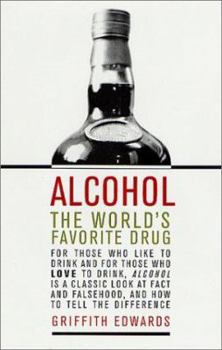Alcohol: The World's Favorite Drug
Select Format
Select Condition 
Book Overview
Alcohol can be an item of diet, a medicine, sometimes an element in religious ritual. It is a valued object for the connoisseur, a traded commodity and a symbol of national pride (wine for instance in France, whisky in Scotland). The range of social and medical problems associated with alcohol and the history of related treatment methods (including the temperance movement, prohibition, AA and a range of contemporary approaches) are considered here. Already considered a classic in the field in England, Alcohol has proved to be fascinating reading for drinkers and nondrinkers alike.
Format:Hardcover
Language:English
ISBN:0312283873
ISBN13:9780312283872
Release Date:April 2002
Publisher:Thomas Dunne Books
Length:240 Pages
Weight:0.90 lbs.
Dimensions:0.8" x 5.8" x 8.6"
Customer Reviews
1 rating
Quick Overview of Not-Too-Oft Discussed Topic
Published by Thriftbooks.com User , 17 years ago
This is not an in-depth sceintific study of alcohol and how Western societies deal with it. It is a brief overview of various aspects - chemistry, myth, and history - of the (currently) most popular drug. There are many other books on the subject that go into greater detail on various aspects, but this one is a very good review of the current state of alcohol in our society, and the past and current methodologies employed to deal with addiction to it. What I found most significant about the book is the final chapter, dealing w/ the consequences of "another drink". The statistics indicate e.g. that each additional drink/day/year for an adult woman increases her chances of breast cancer by 9%. I.e. a woman who has 2 drinks/day (*not* an alcoholic by current measures) increases her chances of breast cancer by 18% vs a non-drinker, all other variables controlled. The public health implications of this are very understated in the text, but staggering nonetheless. Edwards leaves you with an understanding that alcohol is a very potent drug that is heavily laden w/ sociological myth, and therefore no simple solutions to the problems it creates are easily available.





